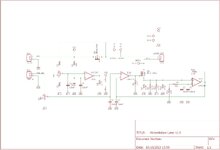Gigillo74
Member level 3
- Joined
- Aug 24, 2007
- Messages
- 61
- Helped
- 0
- Reputation
- 0
- Reaction score
- 1
- Trophy points
- 1,288
- Location
- Bologna - Italy
- Activity points
- 1,662
Hi all,
i'm going to use the driver shown in attached image and i've a laser fault due to strange driver functionally.
So i've decided to do rev.eng. of this driver to know how it work.


I've just noted there is no current feedback on power mosfet and the current feedback from opamp is connected on pin n. 5 (feedback on voltage regulator IC)
Someone can explain me this strange issue?
Thank You.
i'm going to use the driver shown in attached image and i've a laser fault due to strange driver functionally.
So i've decided to do rev.eng. of this driver to know how it work.
I've just noted there is no current feedback on power mosfet and the current feedback from opamp is connected on pin n. 5 (feedback on voltage regulator IC)
Someone can explain me this strange issue?
Thank You.
